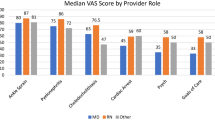Abstract
Objective
To examine patient satisfaction and willingness to return to an emergency department (ED) among non-English speakers.
Design
Cross-sectional survey and follow-up interviews 10 days after ED visit.
Setting
Five urban teaching hospital EDs in the Northeastern United States.
Patients
We surveyed 2,333 patients who presented to the ED with one of six chief complaints.
Measurements and main results
Patient satisfaction, willingness to return to the same ED if emergency care was needed, and patient-reported problems with care were measured. Three hundred fifty-four (15%) of the patients reported English was not their primary language. Using an overall measure of patient satisfaction, only 52% of non-English-speaking patients were satisfied as compared with 71% of English speakers (p<.01). Among non-English speakers, 14% said they would not return to the same ED if they had another problem requiring emergency care as compared with 9.5% of English speakers (p<.05). In multivariate analysis adjusting for hospital site, age, gender, race/ethnicity, education, income, chief complaint, urgency, insurance status. Medicaid status, ED as the patient’s principal source of care, and presence of a regular provider of care, non-English speakers were significantly less likely to be satisfied (odds ratio [OR] 0.59; 95% confidence interval [CI] 0.39, 0.90) and significantly less willing to return to the same ED (OR 0.57; 95% CI 0.34, 0.95). Non-English speakers also were significantly more likely to report overall problems with care (OR 1.70; 95% CI 1.05, 2.74), communication (OR 1.71; 95% CI 1.18, 2.47), and testing (OR 1.77; 95% CI 1.19, 2.64).
Conclusions
Non-English speakers were less satisfied with their care in the ED, less willing to return to the same ED if they had a problem they felt required emergency care, and reported more problems with emergency care. Strategies to improve satisfaction among this group of patients may include appropriate use of professional interpreters and increasing the language concordance between patients and providers.
Similar content being viewed by others
References
Statistical Abstract of the US 1990 Census, 113th ed. Washington, DC: US Bureau of the Census; 1993.
Woloshin S, Bickell NA, Schwartz LM, Francesca G, Welch G. Language barriers in medicine. JAMA. 1995;273:724–8.
Chang PH, Fortier JP. Language barriers to health care: an overview. J Health Care Poor Underserved. 1998;9(suppl 1):S5–19.
Torres RE. The pervading role of language on health. J Health Care Poor Underserved. 1998;9(suppl 1):S21–5.
Kirkmann-Liff B, Mondragon D. Language of interview: relevance for research of southwest Hispanics. Am J Public Health. 1991;81:1399–404.
Baker DW, Parker RM, Williams MV, Coates WC, Pitkin K. Use and effectiveness of interpreters in an emergency department. JAMA. 1996;275:783–8.
Meridith LS, Siu AL. Variation and quality of self-report health data—Asians and Pacific Islanders compared with other ethnic groups. Med Care. 1995;33:1120–31.
Harpole LH, Orav EJ, Hickey M, Posther KE, Brennan TA. Patient satisfaction in the ambulatory setting—influence of data collection methods and sociodemographic factors. J Gen Intern Med. 1996;11:431–4.
Grumback K, Keane D, Bindman A. Primary care and public emergency department overcrowding. Am J Public Health. 1993; 83:372–8.
Baker DW, Stevens CD, Brook RH. Determinants of emergency department use by ambulatory patients at an urban hospital. Ann Emerg Med. 1995;25:311–6.
Baker DW, Stevens CD, Brook RH. Regular source of ambulatory care and medical care utilization by patients presenting to a public hospital emergency department. JAMA. 1994;271:1909–12.
Cronbach LJ. Coefficient alpha and the internal structure of tests. Psychometrika. 1951;16:297–334.
Cleary PD, Edgman-Levitan S, Roberts M, et al. Patients evaluate their health care: a national survey. Health Aff (Millwood). 1991;10:254–67.
Baker DW, Stevens CD, Brook RH. Patients who leave a public hospital emergency department without being seen by a physician: causes and consequences. JAMA. 1991;266:1085–90.
Tumulty P. What is a clinician and what does he do? N Engl J Med. 1970;283:20–4.
Hulka BS, Kupper LL, Daly MB, Cassel JC, Schoen F. Correlates of satisfaction and dissatisfaction with medical care: a community perspective. Med Care. 1975;13:648–58.
Manson A. Language concordance as a determinant of patient compliance and emergency room use in patients with asthma. Med Care. 1988;26:1119–28.
Todd KH, Samaroo N, Hoffman JR. Ethnicity as a risk factor for inadequate emergency department analgesia. JAMA. 1993;269:1537–9.
Perez-Stable EJ, Napoles-Springer A, Miramontes JM. The effects of ethnicity and language on medical outcomes of patients with hypertension or diabetes. Med Care. 1997;35:1212–9.
Seijo R, Gomez H, Freidenberg J. Language as a communication barrier in medical care for Latino patients. Hisp J Behav Sci. 1991;13:363–76.
Riddick SH. Improving access for limited English-speaking consumers: a review of strategies in health care settings. J Health Care Poor Underserved. 1998;9(suppl 1):S40–61.
Perez-Stable EJ. Issues in Latino health care. West J Med. 1987; 146:213–8.
Putsch RW. Cross-cultural communication—the special case of interpreters in health care. JAMA. 1985;254:3344–8.
Vasquez C, Javier RA. The problem with interpreters: communicating with Spanish speaking patients. Hosp Commun Psychiatry. 1991;42:163–5.
Hornberger JC, Gibson CD, Wood W, et al. Eliminating language barriers for Non-English speaking patients. Med Care. 1996;34:845–56.
Osmond DH, Vranizan K, Schillinger D, Stewart AL, Bindman AB. Measuring the need for medical care in an ethnically diverse population. Health Serv Res. 1996;31:551–71.
Williams MV, Parker RM, Baker DW, et al. Inadequate functional health literacy among patients at two public hospitals. JAMA. 1995;274:1677–82.
Blumenthal D. Quality of care—what is it? N Engl J Med. 1996; 335:891–4.
National Committee for Quality Assurance: Health Plan Employers Data and Information Set (HEDIS) 3.0 Washington, DC: NCQA: 1998.
Author information
Authors and Affiliations
Rights and permissions
About this article
Cite this article
Carrasquillo, O., Orav, E.J., Brennan, T.A. et al. Impact of language barriers on patient satisfaction in an emergency department. J Gen Intern Med 14, 82–87 (1999). https://doi.org/10.1046/j.1525-1497.1999.00293.x
Issue Date:
DOI: https://doi.org/10.1046/j.1525-1497.1999.00293.x



